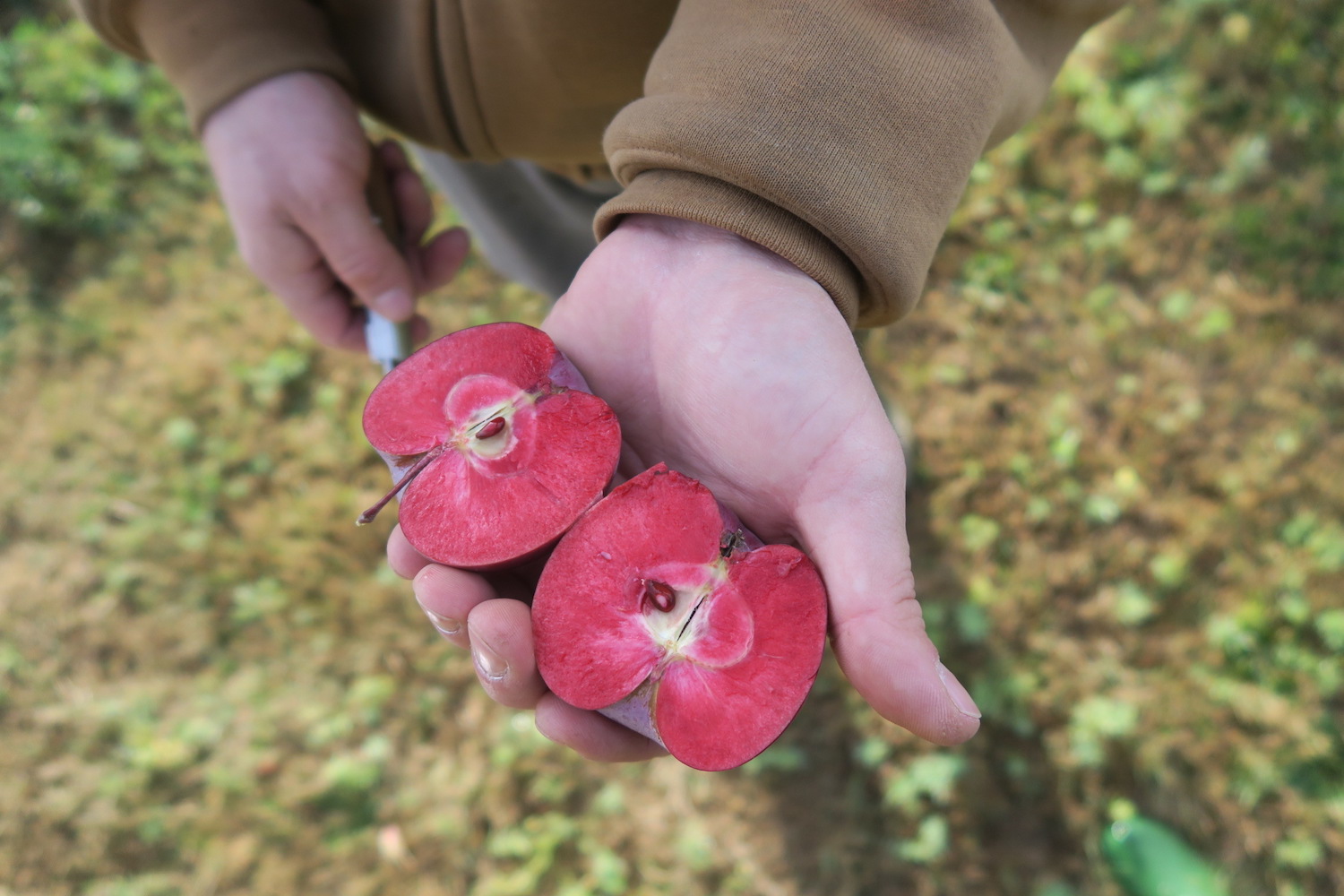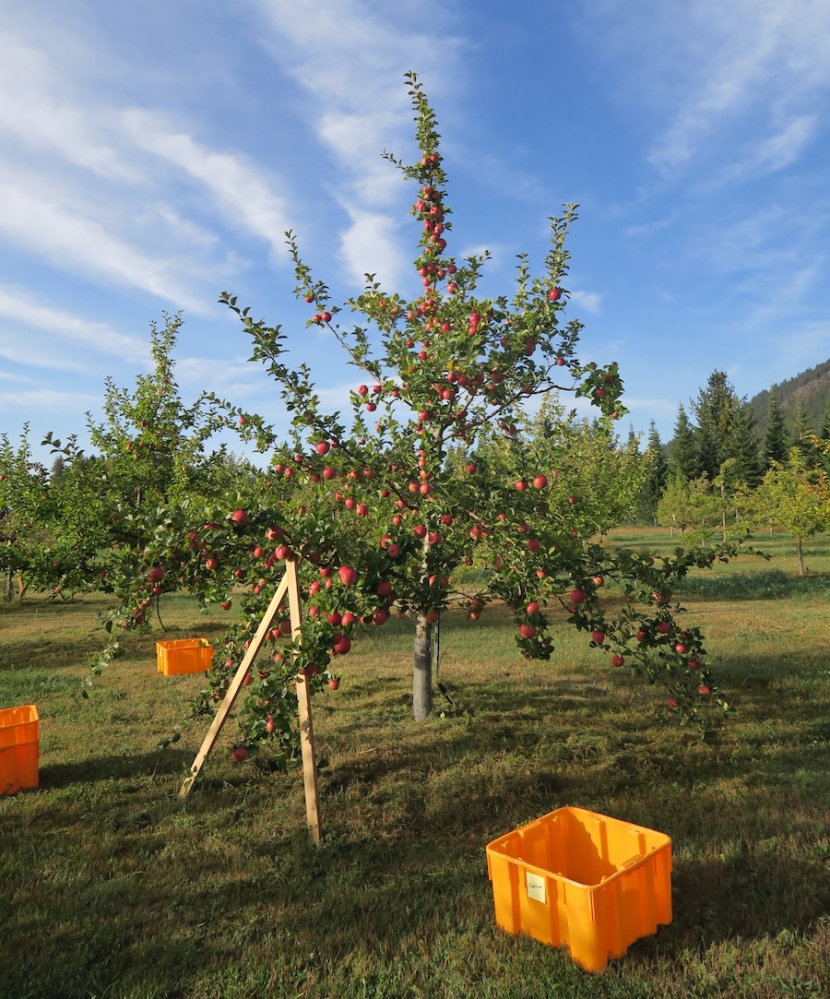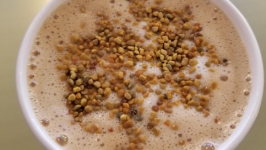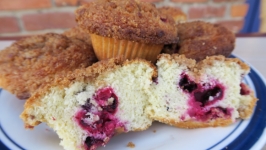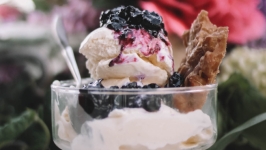Meeting Beneath the Trees
A sparkling dew combines with the crisp, sunny morning to remind everyone in the orchard that winter isn’t far off. Kyle Nagy gives directions for which fruit is ready for harvest as a crew of three women and two dogs mill about, preparing to place ladders, part branches and fill their large canvas bags with apples. Labeled orange bins dot the rows between trees and Nagy makes the rounds, cutting into fruit he suspects is ready, passing around pieces of tangy, sweet apple flesh for crew approval.
It’s the last week of September, and harvest time is in full swing at the University of Idaho Sandpoint Organic Agriculture Center (SOAC). The 66-acre property lays claim to 68 varieties of apples, eight types of pears and eight other fruits including cherries, raspberries and plums.
Just a handful of samples from that dewy Wednesday morning harvest show off the plethora of apple personalities available in the currently eight-acre orchard, located on North Boyer Road at the base of Schweitzer Mountain. A rich golden apple will soon know a future as cider, while a shiny, almost fuschia apple tastes like candy straight from the branch.
“It’s just so unique—all the different flavors you can get from one species of fruit,” says Nagy, who serves as orchard operations manager. “It’s pretty amazing.”
According to UI, North America was once home to over 15,000 varieties of apples. Of those, only 3,000 are produced right now and 90% of commercially grown apples come from only 11 of those varieties. Part of the SOAC mission is to preserve and document the heirloom varieties that are so quickly disappearing from orchards across the country, while also learning which varieties do best in the North Idaho climate. Nagy says the fruit grown at SOAC is currently sold at Yoke’s Fresh Market in Ponderay and Winter Ridge Natural Foods in Sandpoint.
The Sandpoint Organic Agriculture Center also has about eight acres for organic hay production, and Nagy is currently in the process of transitioning another 20 acres to organic— an area which will be ready for crops in about two years, he says.
The SOAC facilities, which Sandpoint resident Dennis Pence donated to UI partially in 2007 and wholly in 2018, include not only the many acres of orchard and crop field, but also a large conference center, a bunkhouse capable of sleeping 35 people and a cottage that sleeps seven. The expansive land and accompanying outbuildings create a perfect environment for UI professors to bring their students and for the UI Extension Office to host classes.
“We’re trying to keep producers in mind as well, because that’s our main goal—to have organic research out here, because a lot of grants for organic research require the work be done on a certified organic farm,” Nagy says.
“This is the university’s only certified organic [facility], so it can really open up a lot of possibilities for researchers and graduate students to do research up here.”
It’s all about maximizing learning opportunities for UI students and established farmers alike, bringing the university to the community and vice versa, says Michael P. Parrella, dean of the UI College of Agricultural and Life Sciences (CALS). He says the areas of study that could benefit from SOAC are plentiful.
“SOAC gives us the opportunity to expand our ability to conduct community-focused programs and offer new ways to enhance undergraduate and graduate education,” Parrella says. “It also enhances the ongoing work of our University of Idaho Extension faculty and creates a space for educational programming on topics like biological control, pollinators, soil health, native plant landscaping, horticulture, organic food processing and marketing, food safety and nutrition.”
Robert Tripepi, a UI professor of plant sciences, says his students are already utilizing SOAC, having planted a native plant trial garden in August. He says the garden will help “to see which native plants from the Intermountain West will thrive or grow poorly in North Idaho,” and then to share that information with home gardeners and green industry professionals in the area. He says a future project his fellow faculty members are planning at SOAC includes weed control using organic practices.
“We would like to highlight sustainable practices for agronomic and horticultural crop production with research and outreach projects, which can then be used for educational purposes for our students as well as the crop producers and the general public,” Tripepi says. “Overall, we in the Department of Plant Sciences are very fortunate to have the SOAC since it serves our needs for teaching, research and extension.”
As for a solidified future vision for day-to-day SOAC operations, Nagy says UI and CALS are still in the beginning stages, but that he’s excited for what’s to come.
“We’re still developing the master plan for the whole thing, but man—there’s so many possibilities out here for research,” Nagy says.
“It’s one thing to have all these varieties here for the community to find out more about … [but it’s also about] getting information about all these varieties that nobody’s heard of out to the locals, or even to the region, so that people know they can plant something in their backyard that’s not a Honeycrisp or a Fuji.”


